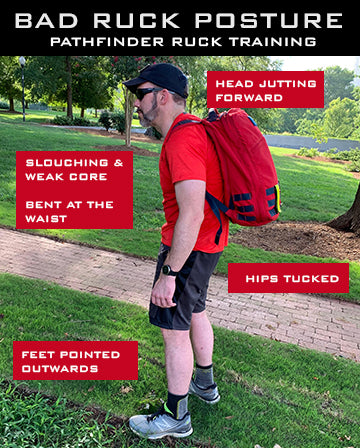Welcome to PATHFINDER Horizon! This content is exclusive to PATHFINDER Horizon subscribers. New classes begin monthly. Contact support@pathfinderrucktraining.com to find out how you can join today!


Humans have been carrying heavy things on their backs since the dawn of time. Giant water jugs, antelopes, big backpacks with cast iron plates...if we were built to carry heavy sh*t, why can rucking be so uncomfortable sometimes?
Poor posture.
Most of us have been to an event where the participant next to us has been plodding along, feet splayed outward, their gut paunched, shoulders rounded, and their neck jutting forward like their head might roll off at any minute. We've all felt sorry for that guy because dang, that looks like it hurts.
Posture is at the core of human movement. Good posture is important to have in our every-day lives to breathe better, keep your body in alignment, prevent fatigue, help you have fewer headaches and basically looker hotter. Without proper rucking posture, our bodies collapse inwardly, weakening our core and muscular stability, and we make ourselves more prone to injury, aches, and pains. An imbalanced spine is an easy thing to get these days, with phones giving us "text neck" and frequent or extended sitting tightening our hip flexors, which doesn't do our spines, hips, and butts any favors.
So how do we ruck with better posture?
- Begin with how your ruck fits. It should fit snugly to your core with the heaviest objects (like your plate) closest to your spine, and make sure the ruck itself is properly and tightly packed.
- As you begin to walk, make sure your eyes are looking at the road ahead and not the ground. Maintain this posture for the duration of your ruck. Your ears should be set over your shoulders, head held high. Did you know your head weighs between 10 and 12 pounds? And did you know that bad posture can put up to 60 pounds of extra pressure on your neck? OUCH. You may feel at first like you're giving yourself a double chin but guess what? That's good posture.
- The weight of your ruck changes your center of gravity. Lean forward a little to accommodate for the added weight. Always bend slightly at the hips, never the waist. Think more Yoda riding on your back and less Atlas carrying the world.
- Consider your core. Tighten your core muscles as you walk, standing tall and help gird your spine. You shouldn't have to work too hard at this, but instead, keep a focus on feeling your muscles engaging as you walk. Breathe normally. Your spine should never be curved inward or outward, but instead, have a neutral position against the back of your ruck.
- Often, a ruck forces good posture across your chest and upper back, so use that benefit to stay mindful of your arms swinging slightly bent at your sides, but never crossing across the front of your body. Your arms are a counterbalance to your leg movement, so get those thumbs out of your straps.
- Be careful not to swagger. We know you're cool and all, but leave that mess for your mama. Long distances can and often do degrade postural control (fancy for standing up straight as you walk) and swaying your hips or sticking your butt out or tucking it in as you walk throws your pelvis out of alignment, tightens up your lower back, and can eventually make each step torturous and also cause you to roll your feet differently, leading to new blisters.
- Instead of that tempting swagger, walk with your knees and toes pointed forward, rolling your foot from heel to toe. Engage your hip flexors and glutes to give your stride power and fluid motion. Stay aware of this effort throughout your event. It might even be helpful to designate a 'posture buddy' teammate and have them remind you when your posture gets sloppy.
Keep these tips in mind for your daily life, and they'll be there to help you when the miles start adding up. It's always tempting to let your form slip as you tire, but by engaging your core and keeping your body and spine in alignment, you are ensuring your body stays injury-free and that it will be ready to go when you are.
